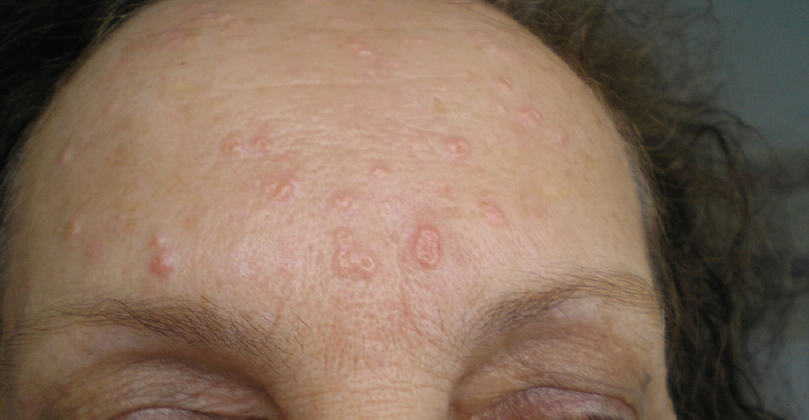Sebaceous hyperplasia in neonates and adults
Piotr Brzezinski1, Anca Chiriac2,3
Sir,
Sebaceous hyperplasia is a common benign proliferation of the sebaceous glands seen during the first weeks of life and in middle-aged and elderly people. Clinical picture is quite different in neonatal period compared to adulthood.
In neonate the lesions are small, tiny yellow papules distributed on the nose [1].
Sebaceous hyperplasia is a quite common finding in neonatal period, being reported in 894 (89.4%) neonates, with a slight predominance of males vs. females: 1.08/1in a recent Australian survey [2].
Sebum secretion is high in neonates probably induced by maternal androgen: dehydroepiandrosterone transferred trans-placental [1].
It is also named “the miniature puberty of the newborn” along with vaginal bleeding in infant girls and neonatal acne (Fig. 1).

Figure 1: Neonatal sebaceous hyperplasia
Sebaceous hyperplasia is a benign finding and spontaneously resolves with time. No evaluation is needed and no treatment is necessary. Reassurance of the family members is of great importance.
In adults soft, yellow papules with central umbilication are noticed not only on the face (particularly on the forehead), also on the genitalia, areola, chest [3] (Fig. 2).

Figure 2: Adult sebaceous hyperplasia
In adults variable treatment methods have been tried for esthetic reasons: electrodessication, light lasers, applications of acids and photodynamic therapy with deceivable results and sometimes scars. Despite numerous séances of therapy rapid recurrences have been noted, explained at least partially, by the lack of penetrance of treatment, only superficial layers are treated [1].
No abnormal levels of hormones have been proved in patients with sebaceous hyperplasia regardless the age.
In elderly persons sebaceous hyperplasia is induced by reduced androgen levels followed by a secondary diminish of cellular turnover [1,2]. Higher sensitivity of the sebaceous cells to androgens would be a trigger to cellular proliferation especially in genital area [4].
Skin biopsy is not necessary; diagnostic is purely clinic, although histological report would confirm a lobular array of well-differentiated mature sebaceous lobules.
Neonatal sebaceous gland hyperplasia is a frequent clinical observation, different from adult form that requires no treatment, no surveillance and no prediction to evolution to later form of the disease (Tab. 1).
Table 1: Differences between neonatal and adult form of sebaceous hyperplasia

CONSENT
The examination of the patients was conducted according to the Declaration of Helsinki principles. Written informed consent was obtained from the patients for publication of this article and any accompanying images. A copy of the written consent is available for review by the Editor-in-Chief of this journal.
REFERENCES
1. Brzeziński P, [Dermatology of neonatal period–skin diseases undemanding of treatment]Przegl Lek 2009; 66: 535-7.
2. Haveri FT, Inamadar AC, A cross-sectional prospective study of cutaneous lesions in newbornISRN Dermatol 2014; 20: 360590.
3. Winstanley D, Blalock T, Houghton N, Ross EV, Treatment of sebaceous hyperplasia with a novel 1,720-nm laserJ Drugs Dermatol 2012; 11: 1323-6.
4. Ortiz-Rey JA, Martín-Jiménez A, Alvarez C, De La Fuente A, Sebaceous gland hyperplasia of the vulvaObstet Gynecol 2002; 99: 919-21.
Notes
Source of Support: Nil
Conflict of Interest: None declared.
Comments are closed.